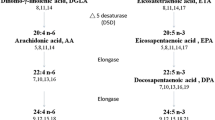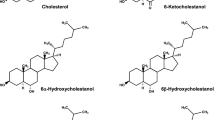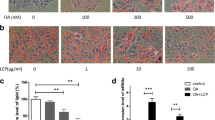Abstract
Pine nut oil (PNO) was reported to reduce lipid accumulation in the liver. However, the specific effect of pinolenic acid (18:3, all-cis-Δ5,9,12), a unique component of PNO, on lipid metabolism has not been studied. We hypothesized that pinolenic acid downregulates the lipid anabolic pathway in HepG2 cells. HepG2 cells were incubated in serum-free medium supplemented with 50 μM bovine serum albumin (BSA), palmitic acid, oleic acid, γ-linolenic acid, pinolenic acid, eicosapentaenoic acid (EPA), or α-linolenic acid for 24 h. Lipid accumulation was determined by Oil Red O (ORO) staining. The mRNA levels of genes related to fatty acid biosynthesis (SREBP1c, FAS, SCD1, and ACC1), fatty acid oxidation (ACC2, PPARα, CPT1A, and ACADL), cholesterol synthesis (SREBP2 and HMGCR), and lipoprotein uptake (LDLr) and of genes that may be involved in the downregulation of the lipogenic pathway (ACSL3, ACSL4, and ACSL5) were determined by qPCR. LDLR protein levels were measured by Western blot analysis. The mRNA levels of SREBP1c, FAS, and SCD1 were significantly downregulated by pinolenic acid treatment compared to BSA control (53, 54, and 38 % lower, respectively). In addition, the mRNA levels of HMGCR, ACSL3, and LDLr were significantly lower (30, 30, and 43 % lower, respectively), and ACSL4 tended to be lower in the pinolenic acid group (20 % lower, P = 0.082) relative to the control group. In conclusion, pinolenic acid downregulated the lipid anabolic pathway in HepG2 cells by reducing expression of genes related to lipid synthesis, lipoprotein uptake, and the regulation of the lipogenic pathway.







Similar content being viewed by others
Abbreviations
- ACADL:
-
Acyl-CoA dehydrogenase long chain
- ACC:
-
Acetyl-CoA carboxylase
- ACSL:
-
Long chain acyl coenzyme A synthase
- ARA:
-
Arachidonic acid
- BSA:
-
Bovine serum albumin
- CPT1A:
-
Carnitine palmitoyl transferase 1
- DHA:
-
Docosahexaenoic acid
- EPA:
-
Eicosapentaenoic acid
- FAS:
-
Fatty acid synthase
- HMGCR:
-
3-Hydroxy-3-methyl-glutaryl-CoA reductase
- LDL:
-
Low density lipoprotein
- LDLr:
-
Low density lipoprotein receptor
- OLA:
-
Oleic acid
- PAM:
-
Palmitic acid
- PNA:
-
Pinolenic acid
- PNO:
-
Pine nut oil
- PPARα:
-
Peroxisome proliferator-activated receptor alpha
- PUFA:
-
Polyunsaturated fatty acid
- SCD1:
-
Stearoyl-CoA desaturase 1
- SREBP:
-
Sterol regulatory element-binding protein
References
Wolff RL, Pédrono F, Pasquier E et al (2000) General characteristics of Pinus spp. seed fatty acid compositions, and importance of Δ5-olefinic acids in the taxonomy and phylogeny of the genus. Lipids 35:1–22
Wolff R (1998) A practical source of Delta 5-olefinic acids for identification purposes. J Am Oil Chem Soc 75:891–892
Wolff RL, Bayard CC (1995) Fatty acid composition of some pine seed oils. J Am Oil Chem Soc 72:1043–1046
No DS, Kim I-H (2013) Pinolenic acid as a new source of phyto-polyunsaturated fatty acid. Lipid Technol 25:135–138
Ferramosca A, Savy V, Einerhand A et al (2008) Pinus koraiensis seed oil (PinnoThinTM) supplementation reduces body weight gain and lipid concentration in liver and plasma of mice. J Anim Feed Sci 487:47
Asset G, Staels B, Wolff RL et al (1999) Effects of Pinus pinaster and Pinus koraiensis seed oil supplementation on lipoprotein metabolism in the rat. Lipids 34:39–44
Park S, Lim Y, Shin S et al (2013) Impact of Korean pine nut oil on weight gain and immune responses in high-fat diet-induced obese mice. Nutr Res Pract 7:352–358
Sugano M, Ikeda I, Wakamatsu K et al (1994) Influence of Korean pine (Pinus koraiensis)-seed oil containing cis-5, cis-9, cis-12-octadecatrienoic acid on polyunsaturated fatty acid metabolism, eicosanoid production and blood pressure of rats. Br J Nutr 72:775–783
Le NH, Shin S, Tu TH et al (2012) Diet enriched with Korean pine nut oil improves mitochondrial oxidative metabolism in skeletal muscle and brown adipose tissue in diet-induced obesity. J Agric Food Chem 60:11935–11941
Ferramosca A, Savy V, Conte L et al (2008) Dietary combination of conjugated linoleic acid (CLA) and pine nut oil prevents CLA-induced fatty liver in mice. J Agric Food Chem 56:8148–8158
Knebel B, Haas J, Hartwig S et al (2012) Liver-specific expression of transcriptionally active SREBP-1c is associated with fatty liver and increased visceral fat mass. PLoS One 7:e31812
Shimano H (2001) Sterol regulatory element-binding proteins (SREBPs): transcriptional regulators of lipid synthetic genes. Prog Lipid Res 40:439–452
Kim JH, Lee HJ, Jeong SJ et al (2012) Essential oil of Pinus koraiensis leaves exerts antihyperlipidemic effects via up-regulation of low-density lipoprotein receptor and inhibition of acyl-coenzyme A:cholesterol acyltransferase. Phytother Res. 26:1314–1319
Dong B, Singh AB, Chin Fung KK et al (2014) CETP inhibitors downregulate hepatic LDL receptor and PCSK9 expression in vitro and in vivo through a SREBP2 dependent mechanism. Atherosclerosis 235:449–462
Bu SY, Mashek DG (2010) Hepatic long-chain acyl-CoA synthetase 5 mediates fatty acid channeling between anabolic and catabolic pathways. J Lipid Res 51:3270–3280
Poudyal H, Panchal SK, Ward LC et al (2013) Effects of ALA, EPA and DHA in high-carbohydrate, high-fat diet-induced metabolic syndrome in rats. J Nutr Biochem 24:1041–1052
Levy JR, Clore JN, Stevens W (2004) Dietary n-3 polyunsaturated fatty acids decrease hepatic triglycerides in Fischer 344 rats. Hepatology 39:608–616
Tsuzuki T, Kawakami Y, Suzuki Y et al (2005) Intake of conjugated eicosapentaenoic acid suppresses lipid accumulation in liver and epididymal adipose tissue in rats. Lipids 40:1117–1123
Iio A, Ito M, Itoh T et al (2013) Molecular hydrogen attenuates fatty acid uptake and lipid accumulation through downregulating CD36 expression in HepG2 cells. Med Gas Res 3:6
Fujimoto Y, Onoduka J, Homma KJ et al (2006) Long-chain fatty acids induce lipid droplet formation in a cultured human hepatocyte in a manner dependent of Acyl-CoA synthetase. Biol Pharm Bull 29:2174–2180
Kuang Y-L, Eric Paulson K, Lichtenstein AH et al (2012) Regulation of the expression of key genes involved in HDL metabolism by unsaturated fatty acids. Br J Nutr 108:1351–1359
Teran-Garcia M, Adamson A, Yu G et al (2007) Polyunsaturated fatty acid suppression of fatty acid synthase (FASN): evidence for dietary modulation of NF-Y binding to the Fasn promoter by SREBP-1c. Biochem J 402:591–600
Mater MK, Thelen AP, Pan DA et al (1999) Sterol response element-binding protein 1c (SREBP1c) is involved in the polyunsaturated fatty acid suppression of hepatic S14 gene transcription. J Biol Chem 274:32725–32732
Xu J, Teran-Garcia M, Park JH et al (2001) Polyunsaturated fatty acids suppress hepatic sterol regulatory element-binding protein-1 expression by accelerating transcript decay. J Biol Chem 276:9800–9807
Nakatani T, Kim HJ, Kaburagi Y et al (2003) A low fish oil inhibits SREBP-1 proteolytic cascade, while a high-fish-oil feeding decreases SREBP-1 mRNA in mice liver: relationship to anti-obesity. J Lipid Res 44:369–379
Caputo M, Zirpoli H, Torino G et al (2011) Selective regulation of UGT1A1 and SREBP-1c mRNA expression by docosahexaenoic, eicosapentaenoic, and arachidonic acids. J Cell Physiol 226:187–193
Vallett SM, Sanchez HB, Rosenfeld JM et al (1996) A direct role for sterol regulatory element binding protein in activation of 3-hydroxy-3-methylglutaryl coenzyme A reductase gene. J Biol Chem 271:12247–12253
Postic C, Girard J (2008) Contribution of de novo fatty acid synthesis to hepatic steatosis and insulin resistance: lessons from genetically engineered mice. J Clin Investig 118:829–838
Haas ME, Attie AD, Biddinger SB (2013) The regulation of ApoB metabolism by insulin. Trends Endocrinol Metab 24:391–397
Costet P, Cariou B, Lambert G et al (2006) Hepatic PCSK9 expression is regulated by nutritional status via insulin and sterol regulatory element-binding protein 1c. J Biol Chem 281:6211–6218
Brown MS, Goldstein JL (1999) A proteolytic pathway that controls the cholesterol content of membranes, cells, and blood. Proc Natl Acad Sci 96:11041–11048
Sandoval A, Fraisl P, Arias-Barrau E et al (2008) Fatty acid transport and activation and the expression patterns of genes involved in fatty acid trafficking. Arch Biochem Biophys 477:363–371
Bu SY, Mashek MT, Mashek DG (2009) Suppression of long chain acyl-CoA synthetase 3 decreases hepatic de novo fatty acid synthesis through decreased transcriptional activity. J Biol Chem 284:30474–30483
Kassan A, Herms A, Fernández-Vidal A et al (2013) Acyl-CoA synthetase 3 promotes lipid droplet biogenesis in ER microdomains. J Cell Biol 203:985–1001
Westerbacka J, Kolak M, Kiviluoto T et al (2007) Genes involved in fatty acid partitioning and binding, lipolysis, monocyte/macrophage recruitment, and inflammation are overexpressed in the human fatty liver of insulin-resistant subjects. Diabetes 56:2759–2765
Kan CFK, Singh AB, Stafforini DB et al (2014) Arachidonic acid down regulates acyl-CoA synthetase 4 expression by promoting its ubiquitination and proteasomal degradation. J Lipid Res 55:1657–1667
Sampath H, Ntambi JM (2005) Polyunsaturated fatty acid regulation of genes of lipid metabolism. Annu Rev Nutr 25:317–340
Moon YS, Latasa M-J, Griffin MJ et al (2002) Suppression of fatty acid synthase promoter by polyunsaturated fatty acids. J Lipid Res 43:691–698
Howell G 3rd, Deng X, Yellaturu C et al (2009) N-3 polyunsaturated fatty acids suppress insulin-induced SREBP-1c transcription via reduced trans-activating capacity of LXRα. Biochim Biophys Acta 1791:1190–1196
Jelenik T, Rossmeisl M, Kuda O et al (2010) AMP-activated protein kinase α2 subunit is required for the preservation of hepatic insulin sensitivity by n-3 polyunsaturated fatty acids. Diabetes 59:2737–2746
Acknowledgments
This work was supported by Basic Science Research Program through the National Research Foundation of Korea funded by the Ministry of Education (Grant Number NRF-2010-0024878).
Author information
Authors and Affiliations
Corresponding author
About this article
Cite this article
Lee, A.R., Han, S.N. Pinolenic Acid Downregulates Lipid Anabolic Pathway in HepG2 Cells. Lipids 51, 847–855 (2016). https://doi.org/10.1007/s11745-016-4149-6
Received:
Accepted:
Published:
Issue Date:
DOI: https://doi.org/10.1007/s11745-016-4149-6




